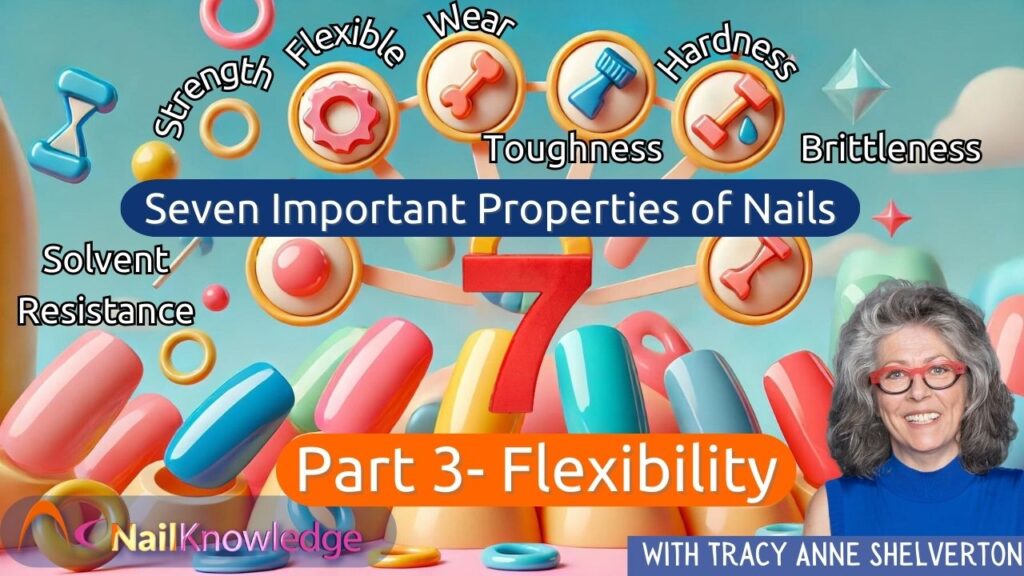Nail Flexibility: The Third Key Property of Natural and Artificial Nails
In this third part of our series on the key properties of natural and artificial nails, we move from strength and hardness to explore flexibility. As we have already discussed, strength is the ability of a material to resist breaking under pressure, while hardness determines how well a material can resist surface scratching or denting. Flexibility, however, is the capacity of a material to bend without breaking. Just as Confucius said, “The green reed which bends in the wind is stronger than the mighty oak which breaks in a storm,” flexibility is essential for nails to absorb impact and avoid damage. This balance between hardness and flexibility is what keeps nails resilient in everyday activities.
What Is Flexibility and Why Is It Important?
Flexibility allows a substance to bend and absorb force without cracking or breaking. This is especially crucial for nails, both natural and artificial, as it prevents them from snapping under stress. Normal, healthy nail plates have a good degree of flexibility, meaning they will bend rather than break when subjected to pressure. Inflexible nails, on the other hand, are more prone to cracking and breaking, which can lead to discomfort and damage to the nail bed.
Several factors influence nail flexibility, including age, diet, overall health, and exposure to harsh chemicals or environmental conditions. For example, long-term or repeated exposure to cleaning agents, water, garden earth and compost and or solvents can make nail plates brittle and reduce their flexibility and make them prone to infections. Nail care professionals need to recognize this balance and select treatments or nail systems that best suit the flexibility of their clients’ nails but also their clients habits, work and hobbies.
Nail Hardness and Flexibility: Finding the Balance
While hardness and flexibility are often confused, they are distinct properties. Nail hardness refers to a nail’s resistance to surface damage like scratching or denting, while flexibility determines how well a nail can bend without breaking. A healthy nail needs both hardness and flexibility. Nails that are too hard may resist (surface) scratching but are at a greater risk of cracking or breaking under pressure. Conversely, overly flexible nails can become weak and prone to breakage.
For artificial nails, striking this balance is equally important. For example, cyanoacrylate-based systems, like fiberglass wraps, are highly flexible. However, they may not reinforce overly flexible natural nails and can lead to lifting, cracking or breakage. In contrast, systems that use monomer liquid and polymer powder, or UV gels, can provide greater strength and protection (depending on the ingredients) for weaker, more flexible nails.
Why Too Much Flexibility Can Be a Problem
While flexibility is necessary, too much of it can also lead to issues. Nails that are excessively flexible can become fragile and prone to damage. A prime example is the use of methyl methacrylate monomer (MMA) in artificial nails, which creates coatings that are too rigid and not flexible enough. This lack of flexibility causes the nail coating to resist bending with the natural nail, leading to a greater risk of severe nail bed damage.
For healthy nails, whether natural or artificial, it’s essential to maintain a degree of flexibility that allows the nail to bend without breaking, while still providing enough strength to withstand daily activities. Products that promote a balance of strength and flexibility matched to the condition of the natural nail are key to ensuring that nails remain healthy, durable, and aesthetically pleasing.
Maintaining Flexibility in Natural and Artificial Nails
To keep nails flexible, it is important to avoid overexposure to harsh chemicals and solvents, which can weaken the nail plate over time. Proper cleansing and the use of nail care products that moisturize and protect the nail can help maintain the flexibility necessary for nail health. When it comes to artificial nails, choosing products that match the natural nails so they can enhance both the appearance and durability of the nails is essential for health of the nails and durability of the enhancement, regardless of the product used.
In conclusion, flexibility is a critical property of both natural and artificial nails. It allows them to give under pressure, preventing cracks and breaks. However, achieving the right balance between nail hardness and flexibility is key to maintaining nail health and nail enhancement durability and performance.
Explore More Key Properties of Nails in Our 7-Part Series:
- Nail Strength – Discover how the strength of nails impacts their performance and durability.
- Nail Hardness – Understand the crucial role of hardness in nail health and how to maintain the perfect balance.
- Nail Flexibility – Understand the importance of flexibility in preventing nail breakage and maintaining resilience.
- Nail Toughness – Find out what makes nails tough and how this property differs from strength and hardness.
- Nail Brittleness – Learn what causes brittleness in nails and how to prevent it.
- Nail Solvent Resistance – Explore how nails can resist damage from chemicals and solvents.
- Nail Wear – Understand the factors that affect how well nails withstand regular use and environmental exposure.
By learning more about flexibility and its interaction with other properties like nail hardness, you’ll gain valuable insights into how to maintain healthy, strong, and resilient nails.


